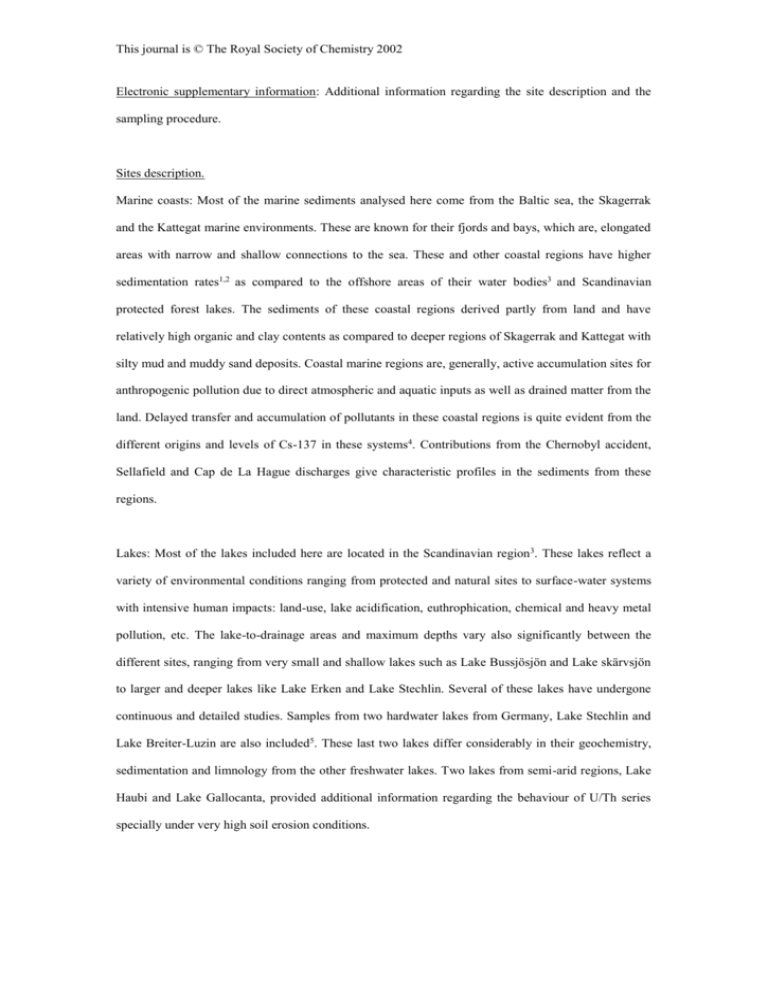Additional information regarding the site description and the
advertisement

This journal is © The Royal Society of Chemistry 2002 Electronic supplementary information: Additional information regarding the site description and the sampling procedure. Sites description. Marine coasts: Most of the marine sediments analysed here come from the Baltic sea, the Skagerrak and the Kattegat marine environments. These are known for their fjords and bays, which are, elongated areas with narrow and shallow connections to the sea. These and other coastal regions have higher sedimentation rates1,2 as compared to the offshore areas of their water bodies3 and Scandinavian protected forest lakes. The sediments of these coastal regions derived partly from land and have relatively high organic and clay contents as compared to deeper regions of Skagerrak and Kattegat with silty mud and muddy sand deposits. Coastal marine regions are, generally, active accumulation sites for anthropogenic pollution due to direct atmospheric and aquatic inputs as well as drained matter from the land. Delayed transfer and accumulation of pollutants in these coastal regions is quite evident from the different origins and levels of Cs-137 in these systems4. Contributions from the Chernobyl accident, Sellafield and Cap de La Hague discharges give characteristic profiles in the sediments from these regions. Lakes: Most of the lakes included here are located in the Scandinavian region3. These lakes reflect a variety of environmental conditions ranging from protected and natural sites to surface-water systems with intensive human impacts: land-use, lake acidification, euthrophication, chemical and heavy metal pollution, etc. The lake-to-drainage areas and maximum depths vary also significantly between the different sites, ranging from very small and shallow lakes such as Lake Bussjösjön and Lake skärvsjön to larger and deeper lakes like Lake Erken and Lake Stechlin. Several of these lakes have undergone continuous and detailed studies. Samples from two hardwater lakes from Germany, Lake Stechlin and Lake Breiter-Luzin are also included5. These last two lakes differ considerably in their geochemistry, sedimentation and limnology from the other freshwater lakes. Two lakes from semi-arid regions, Lake Haubi and Lake Gallocanta, provided additional information regarding the behaviour of U/Th series specially under very high soil erosion conditions. This journal is © The Royal Society of Chemistry 2002 Soils and peat-lands: Soil samples from the catchment area of Lake Härsvatten and Lake Stechlin are also included in our analysis. These soils are mostly covered by forest. These temperate soils were complemented by other ones from Riga. Additional soil samples from two semi-arid regions from the south of Spain and its oceanic islands. The semi-arid soils are quite hard and contain large amounts of mineral material. Ombrotrophic peats, mostly rain-fed, were collected at different latitudes in Europe6,3. These peats may get inputs from the underlying bedrock through limited upward mobility of nutrients and other available chemical species and radionuclides 7. Sampling procedure. Both lake and marine sediments were mostly collected for high-resolution chronological studies using gravity corers. Sediments were also sampled as bulk integrated cores for spatial modelling of fluxes and inventories of chemical and radioactive species. In most cases, the sediment cores were sliced on site. Ombrotrophic peats were sampled using sharp steel corers. The whole cores were clean sealed, transported in frozen conditions and then sliced in the laboratory. The average organic content of these slightly humified matter with still visible stems, and minor remains of vascular plants, was 95%. At some sites, this value dropped somehow in the deepest layers where more soil minerals appeared. Unlike the sediments, where the sampling was carried out in soft bottoms, soils showed large variability with respect to the sampling methods. This is due to the difficulties involved in the sampling of different types of soils. Soft, woodland soils were sampled by lateral cutting with sharp tools. The slicing was done in situ. The organic layer located above the soil horizon was included as part of the soil. Rocks, major vascular plants and roots were avoided and the samples were taken accordingly. Samples of the minor top vegetation were considered separately and have not been included on this paper. These organic materials are expected to give somewhat similar data as those obtained from the top layers of the peats. Hard soils required more compact machinery. A trapezoidal grid was used to determine the area and depth of the samples. The soil material, excluding large pieces of vegetation litter, were then crushed and powdered. This sampling technique only allowed relatively shallow depths (approximately 30 cm). The soils taken in the Málaga region, which are used for Rn-222 emanation studies, were collected using metal tubes allowing deeper cores down to 3 metres. The different soils varied also significantly in composition, from clays to sand, from organic-rich to very This journal is © The Royal Society of Chemistry 2002 mineral matrix, etc. Homogenisation of all the samples was essential. This process was relatively laborious in some peats and soils due to the very different plant features, as in the case of the peats from the catchment of Lake Härsvatten, and the hardness of the mineral components in the soils from Tenerife. References: 1. V. Axelsson and F. El-Daoushy. Geografiska Annaler, 1989, 71A, 87. 2. J.M. Abril, M. Garcia-Leon, R. Garcia-Tenorio, C.I: Sánchez and F. El-Daoushy. J. Env. Radiot., 1992, 15, 135. 3. F. El-Daoushy. Hydrobiologia, 1986, 143, 267. 4. M. McDiarmid, J. Keogh, F. Hooper, K. McPhaul, K. Squibb, R. Kane, R. DiPino, M. Kabat, B. Kaup, L. Andersson, D. Jacobson-Kram, B. Burrows, M. Walsh. Environ. Res., 2000, 82, 162. 5. F. El-Daoushy, P.G. Appleby, M. Garcia-león, P. Casper and G. Ardisson. European Commission. Radiation protection fourth framework programme 1994-1998, project summaries, 2001, ISBN: 92-894-1291-7, 175. 6. A. Van Der Wijk, F. El-Daoushy, A.R. Arends and W.G. Mook. Chem. Geol., 1986, 59, 283. 7. P. Halbach, D.V. Borstel and K.D. Gundermann. Chem. Geology, 1980, 29, 117.









